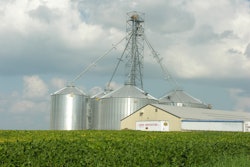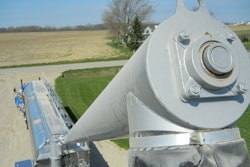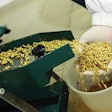Grain processing facilities provide an ideal scenario for salmonella contamination. Dry facilities are rarely decontaminated or cleaned with liquid disinfectants and the huge amount of product going through the facility every day make it ripe for contamination. The product itself can become contaminated from a variety of sources:
- Soil while growing in the field
- Animals walking through the crops
- During harvest from workers or equipment
- During transport in trucks or trains to the grain processing facility
- Pests entering the silos during staging
- During the processing itself
Regardless of where the salmonella originates from, once a facility and its equipment become contaminated, it becomes a source for future contaminations.
Facility description
A 280,000-cubic-foot protein powder grinding, drying and packaging facility had a Salmonella spp. contamination of some of the equipment. The facility was nearly impossible to decontaminate using conventional methods, not only because it was a large facility, but also because of its height. It was 90 feet tall with three floors in need of decontamination (the second through fourth floors). The second and third floors had 20-foot-high ceilings, and the fourth floor had a 40-foot-high ceiling. The facility was also intricate, having equipment ranging from the very large to small. Some areas were very tightly packed, narrow, with lots of sensitive electronics and processing equipment.
Chlorine dioxide gas was used to decontaminate the facility, which consisted of a variety of large rooms and large intricate and sensitive pieces of equipment. These areas included processing, conveyor systems, dryers, packaging, loading docks and offices. There were many different types of materials and surfaces within these facilities, including stainless steel, epoxy-painted walls, raw concrete walls and floors, solid flooring, painted steel cabinets, plastic light fixtures, plastics, conveyor belts, many different types of electronics and rubbers.
Why gaseous chlorine dioxide?
Once it is determined that a facility needs decontamination, there are many possibilities as to which decontamination method would be best. The most common method is spraying/wiping/mopping and fogging/misting with a high level disinfectant and steam. Because the facility is a dry powder facility, basic washing and rinsing are not an option. Liquid disinfectants are not used because they include moisture, which causes organisms to multiply. If a liquid decontamination is not 100% effective, it only fuels microbial growth.
In the past, this facility utilized steam to kill organisms. While steam can work, it is hard to be 100% effective. Since it is creating moisture, if it is not 100% effective, it can make the situation worse. For steam to work, temperatures need to be over 250 F for 15 to 30 minutes. While this sounds easy, metal surfaces dissipate heat rapidly, and cement has a lot of thermal mass and warms slowly.
Because of the limitations of this method, a more thorough process was needed. Three different decontamination agents; vapor phase hydrogen peroxide (VPHP), ozone gas and chlorine dioxide (CD) gas, were considered. All were known to be effective decontaminants for spore and non-spore forming bacteria under ideal laboratory conditions (i.e., clean flat surfaces lacking porous materials or potential dead-legs with which fumigant penetration might be inhibited).
VPHP was not chosen because it quickly condenses and does not get the required distribution. Ozone has too short of a life and breaks down before being distributed throughout the facility.
Chlorine dioxide (CD) gas was chosen because it is a true gas, which can evenly distribute, getting into the cracks and crevices. It is registered as a sterilant with the Environmental Protection Agency, so it gets complete inactivation of all organisms. Chlorine dioxide has also been used to successfully treat food and drinking water for years without leaving residues.
Full decontamination of the facility and all the equipment was critical before starting production again. The persistent problem had existed for years, and pressure was on to finally eradicate it. Since this facility was a supplier of ingredients, their customer was expressing strong concern for the issues. This was also critical financially, since the loss of a customer or recall due to contamination is extremely costly.
Foodborne illnesses cost an estimated $152 billion each year in health-related expenses (Scharff, 2010). The Centers for Disease Control and Prevention estimates that each year roughly one out of six Americans (or 48 million people) is affected, 128,000 are hospitalized and 3,000 die from foodborne diseases each year (CDC, 2011). In addition to the recalled product values, the impact could result in a reduction in sales, product liability claims and image rebuilding costs, along with the cost of restoring status within distribution channels (Gunther, 2010).
The procedure
The decontamination preparation, actual decontamination and cleanup took place over the course of two days. However, prior to the decontamination event, the facility was cleaned of most of the visible dirt. Five engineers from the decontamination service provider supplied the staffing and expertise for the project. The first step was to seal the facility.
The HVAC system was then shut down in order to contain the gas during the process. The supply inlet and exhaust outlet in the mechanical room on the roof were covered and taped with plastic sheeting. The personnel doors (except one used for entry and exit prior to the decontamination) were sealed with duct tape.
Once the sealing was completed, tubing was run. The gas generators were located outside the decontamination areas, and red 1/4-inch tubing was run from the gas generators to the 66 gas inject locations inside the area to be decontaminated.
To measure and record the CD concentration, green 1/4-inch tubing was run from the ClorDiSys Sensor Module to 13 sensing points throughout the area being decontaminated. The sensor module consists of an industrial UV-VIS spectrophotometer, which accurately monitors and logs the concentration/dosage. This enables that the process parameters are met prior to the process being terminated, ensuring that every decontamination cycle is effective.
Fans were then placed throughout the facility to aid the distribution of the gas and humidity.
On the second day, biological indicators (BIs) were placed throughout the facility. B. Stearothermophilus BIs containing 1 million spores each, was chosen because of their resistance. Sixteen (eight pairs) of BIs were placed throughout the facility, mainly in areas that did not have gas sampling or injection points, to demonstrate distribution and provide evidence as to the effectiveness of the process. Each of the BIs was located within areas where environmental swabbing resulted in positive samples for Salmonella spp., or which were considered difficult for the gas to reach.
The gaseous chlorine dioxide process used is registered by Clordisys Solutions Inc. with the EPA (EPA #80802-1) as a sterilant, and if process parameters are met, then biological efficacy is ensured. The validated photometric measurement ensures proper concentrations are met for six-log-sporicidal kill.
Once everything was in place, the process of humidifying was initiated. This step is required to soften spore walls if sporicidal kill is needed. Humidification was accomplished using the in-house steam system. After all the rooms were at the minimum RH level of 65% for a minimum of 30 minutes, the steam systems were shut down. At this point, the gassing process was initiated by opening the 2% reagent gas cylinders to start creating the CD gas.
Results
A CD gas concentration of 1 milligram/liter was targeted and reached. The target concentration of one milligram/liter or 362 ppm has a typical exposure time of two hours, which equates to (362 ppm * two hours) = 724 ppm-hours.
In approximately 4.5 hours, the minimum dosage of 724 ppm-hours was exceeded, and the gas injection was terminated.
Once the desired exposure was completed, aeration was initiated by starting the exhaust system and removing the plastic covering the exhaust grills. Next, the supply was started, and the plastic covering the supply inlets was removed. Within 30 minutes most of the readings were at 0.0 milligram/liter to 0.1 milligram/liter and a few at 0.2 milligram/liter. At 60 minutes, the concentration was at or below 0.1 ppm. (The current Occupational Safety and Health Administration permissible exposure limit (PEL) for chlorine dioxide is 0.1 ppm as an eight-hour time-weighted average (TWA) concentration [29 CFR 1910.1000, Table Z-1]). Sixty minutes after aeration was started, the facility was entered using proper gowning techniques and the fans, injection and sampling tubing were removed. At this point, the decontamination was officially over and the facility was able to start up production once again.
Conclusion
The chlorine dioxide gas decontamination of the 280,000-cubic-foot dry grain facility was successful. This was determined by gas distribution at proper levels as measured by the Clordisys EMS, length of exposure at measured values, complete kill of all biological indicators, lack of positive swabs, no physical residue and no visible indication of material degradation on any of the equipment, lights or electronics left within the building. The area was free of CD gas within one hour of aeration and safe to enter.
During the decontaminations, the entire area surrounding the section of the facility being decontaminated was periodically scanned with a low-level sensor and no leaks were detected.
When implemented as directed, CD has been shown to be a flexible, scalable, practical and effective method for microbial decontamination of large facilities with minimal work, minimal down time and with the effectiveness of a true gas.


















